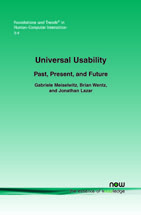Universal Usability: Past, Present, and Future
By Gabriele Meiselwitz, Department of Computer and Information Sciences, Universal Usability Laboratory, Towson University, USA, gmeiselwitz@towson.edu | Brian Wentz, Department of Computer and Information Sciences, Universal Usability Laboratory, Towson University, USA, bwentz2@students.towson.edu | Jonathan Lazar, Department of Computer and Information Sciences, Universal Usability Laboratory, Towson University, USA, jlazar@towson.edu
Abstract
Computers are used all over the world in a variety of contexts by users with all levels of technical experience. This includes users such as kindergarteners, older users, people with various impairments, people who are busy doing other tasks (such as driving a car), and users with differing levels of education, literacy, and socio-economic means. The concept of computer interfaces that will be easy to use, for all of these users, in all of these different situations, is known as "universal usability." Making progress toward this goal requires innovations in techniques for gathering and understanding requirements, designing and developing interfaces, evaluation and assessment, development and use of standards, and public policy, and much work in this field remains to be done. This monograph will present an overview of universal usability as it currently exists in the human–computer interaction literature, and will also present some future directions for work in universal usability.
Universal Usability
Universal Usability: Past, Present, and Future surveys the state-of-the-art of human-computer interaction research into the design and development of interfaces that will be easy to use for users of all levels of technical experience ability. Computers are integrated into our daily lives in many ways. Users with all levels of training and education, users with disabilities, the very young and the very mature are using computers for many different tasks. This diversity makes it challenging for information and communication system designers to provide systems which will be easy to use by all, everywhere. Universal usability addresses this challenge and its goal is to design systems which enable the largest possible group of users to successfully use information and communication technology. Universal Usability: Past, Present, and Future looks at the progress that has been made towards this goal. It outlines the innovations in techniques for gathering and understanding requirements; designing and developing interfaces; evaluation and assessment; standards practices; and public policy. It is an invaluable reference for computer scientists or designers researching or designing information and communication systems that support universal user flexibility, user control, system transparency, availability and accessibility.
